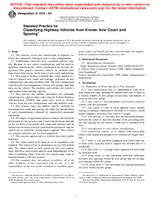We need your consent to use the individual data so that you can see information about your interests, among other things. Click "OK" to give your consent.
ASTM E1572-93
Standard Practice for Classifying Highway Vehicles from Known Axle Count and Spacing (Withdrawn 2002)
STANDARD published on 1.1.1993
The information about the standard:
Designation standards: ASTM E1572-93
Note: WITHDRAWN
Publication date standards: 1.1.1993
SKU: NS-42231
The number of pages: 19
Approximate weight : 57 g (0.13 lbs)
Country: American technical standard
Category: Technical standards ASTM
Annotation of standard text ASTM E1572-93 :
Keywords:
Axle configuration, Classification (standards), Highway vehicles, Unit configuration, Vehicles, highway vehicles-classifying from known axle count/spacing, practice, ICS Number Code 03.220.20 (Road transport)
Additional information
| 1. Scope |
|
1.1 This practice covers the classification of highway vehicles into categories relating to axle or unit configuration. 1.2 Traditionally, observers have classified vehicles visually. Because of cost, safety considerations, and the need for nighttime classifications, visual classification has become impractical. This practice classifies vehicles by methods other than visual observation, on the basis of axle count and spacing. 1.3 This practice defines a method that, when applied to a vehicle's known axle count and spacings, generates an axle configuration code and a modifier code. The axle configuration code describes the arrangement of axles, axle groups, and body units on the vehicle. The modifier code defines the vehicle's approximate load-carrying capacity. 1.4 This practice also defines procedures for optionally computing two- and six-digit codes that the Federal Highway Administration (FHWA) and states have used to classify vehicles from the axle configuration code and modifier code. 1.5 This practice does not address specific methods for measuring axle count and spacing, but rather the interpretation of such measurements obtained by unspecified automated equipment. 1.6 The degree of agreement between vehicle classifications determined by this practice and visual classifications depends on the accuracy of measured axle count and spacings and on interactions between selected classification parameters and the vehicle mix to which the classification is applied. These effects are complex and have not yet been quantified. 1.7 This practice applies only to vehicles that travel public highways. 1.8 The values stated in SI units are to be regarded as the standard. The values given in parentheses are for information only. The values stated in each system are not exact equivalents; therefore, each system must be used independently of the other. Combining values from the two systems may result in nonconformance with this practice. 1.9 This standard does not purport to address all of the safety problems, if any, associated with its use. It is the responsibility of the user of this standard to establish appropriate safety and health practices and determine the applicability of regulatory limitations prior to use. |
We recommend:
Updating of laws
Do you want to be sure about the validity of used regulations?
We offer you a solution so that you could use valid and updated legislative regulations.
Would you like to get more information? Look at this page.




 Cookies
Cookies
